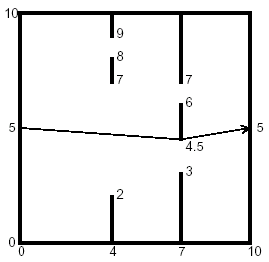http://poj.org/problem?id=1556
首先路径的每条线段一定是端点之间的连线。证明?这是个坑...反正我是随便画了一下图然后就写了..
然后re是什么节奏?我记得我开够了啊...然后再开大点才a...好囧啊.
#include <cstdio>
#include <cstring>
#include <cmath>
#include <string>
#include <iostream>
#include <algorithm>
#include <queue>
#include <set>
#include <map>
using namespace std;
typedef long long ll;
#define rep(i, n) for(int i=0; i<(n); ++i)
#define for1(i,a,n) for(int i=(a);i<=(n);++i)
#define for2(i,a,n) for(int i=(a);i<(n);++i)
#define for3(i,a,n) for(int i=(a);i>=(n);--i)
#define for4(i,a,n) for(int i=(a);i>(n);--i)
#define CC(i,a) memset(i,a,sizeof(i))
#define read(a) a=getint()
#define print(a) printf("%d", a)
#define dbg(x) cout << (#x) << " = " << (x) << endl
#define error(x) (!(x)?puts("error"):0)
#define rdm(x, i) for(int i=ihead[x]; i; i=e[i].next)
inline const int getint() { int r=0, k=1; char c=getchar(); for(; c<'0'||c>'9'; c=getchar()) if(c=='-') k=-1; for(; c>='0'&&c<='9'; c=getchar()) r=r*10+c-'0'; return k*r; }
const double eps=1e-6;
int dcmp(double x) { return abs(x)<eps?0:(x<0?-1:1); }
struct ipoint { double x, y; };
double icross(ipoint &a, ipoint &b, ipoint &c) {
static double x1, x2, y1, y2;
x1=a.x-c.x; y1=a.y-c.y;
x2=b.x-c.x; y2=b.y-c.y;
return x1*y2-x2*y1;
}
int ijiao(ipoint &p1, ipoint &p2, ipoint &q1, ipoint &q2) {
return (dcmp(icross(p1, q1, q2))^dcmp(icross(p2, q1, q2)))==-2 &&
(dcmp(icross(q1, p1, p2))^dcmp(icross(q2, p1, p2)))==-2;
}
const int N=1000;
struct dat { int next, to; double w; }e[N<<2];
int ihead[N], cnt;
void add(int u, int v, double w) {
e[++cnt].next=ihead[u]; ihead[u]=cnt; e[cnt].to=v; e[cnt].w=w;
}
double spfa(int s, int t, int n) {
static double d[N];
static int q[N], front, tail, u, v;
static bool vis[N];
front=tail=0;
for1(i, 0, n) vis[i]=0, d[i]=1e99;
d[s]=0; q[tail++]=s; vis[s]=1;
while(front!=tail) {
u=q[front++]; if(front==N) front=0; vis[u]=0;
rdm(u, i) if(d[v=e[i].to]+eps>d[u]+e[i].w) {
d[v]=d[u]+e[i].w;
if(!vis[v]) {
vis[v]=1;
if(d[v]<d[q[front]]+eps) {
--front; if(front<0) front+=N;
q[front]=v;
}
else { q[tail++]=v; if(tail==N) tail=0; }
}
}
}
return d[t];
}
ipoint p[N], line[N*3][2];
int n, pn, ln;
bool check(ipoint &x, ipoint &y) {
for1(i, 1, ln) if(ijiao(x, y, line[i][0], line[i][1])) return false;
return true;
}
double sqr(double x) { return x*x; }
double dis(ipoint &x, ipoint &y) { return sqrt(sqr(x.x-y.x)+sqr(x.y-y.y)); }
int main() {
while(read(n), n!=-1) {
ln=0; pn=0;
++pn; p[pn].x=0; p[pn].y=5;
++pn; p[pn].x=10; p[pn].y=5;
static double rx, ry[4];
while(n--) {
scanf("%lf", &rx);
rep(k, 4) scanf("%lf", &ry[k]);
++ln; line[ln][0]=(ipoint){rx, 0}; line[ln][1]=(ipoint){rx, ry[0]};
++ln; line[ln][0]=(ipoint){rx, ry[1]}; line[ln][1]=(ipoint){rx, ry[2]};
++ln; line[ln][0]=(ipoint){rx, ry[3]}; line[ln][1]=(ipoint){rx, 10};
rep(k, 4) ++pn, p[pn].x=rx, p[pn].y=ry[k];
}
for1(i, 1, pn) for1(j, 1, pn) if(i!=j && check(p[i], p[j])) add(i, j, dis(p[i], p[j]));
printf("%.2f
", spfa(1, 2, pn));
memset(ihead, 0, sizeof(int)*(pn+1));
cnt=0;
}
return 0;
}
Description
You are to find the length of the shortest path through a chamber containing obstructing walls. The chamber will always have sides at x = 0, x = 10, y = 0, and y = 10. The initial and final points of the path are always (0, 5) and (10, 5). There will also be from 0 to 18 vertical walls inside the chamber, each with two doorways. The figure below illustrates such a chamber and also shows the path of minimal length.


Input
The input data for the illustrated chamber would appear as follows.
2
4 2 7 8 9
7 3 4.5 6 7
The first line contains the number of interior walls. Then there is a line for each such wall, containing five real numbers. The first number is the x coordinate of the wall (0 < x < 10), and the remaining four are the y coordinates of the ends of the doorways in that wall. The x coordinates of the walls are in increasing order, and within each line the y coordinates are in increasing order. The input file will contain at least one such set of data. The end of the data comes when the number of walls is -1.
2
4 2 7 8 9
7 3 4.5 6 7
The first line contains the number of interior walls. Then there is a line for each such wall, containing five real numbers. The first number is the x coordinate of the wall (0 < x < 10), and the remaining four are the y coordinates of the ends of the doorways in that wall. The x coordinates of the walls are in increasing order, and within each line the y coordinates are in increasing order. The input file will contain at least one such set of data. The end of the data comes when the number of walls is -1.
Output
The output should contain one line of output for each chamber. The line should contain the minimal path length rounded to two decimal places past the decimal point, and always showing the two decimal places past the decimal point. The line should contain no blanks.
Sample Input
1 5 4 6 7 8 2 4 2 7 8 9 7 3 4.5 6 7 -1
Sample Output
10.00 10.06
Source